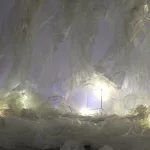
BURLINGTON, Vt. (WCAX) – An art installation at Champlain College is leaving an impact on visitors.
The exhibit at the Champlain College Art Gallery of Art uses plastic to help visualize the impact pollution has on the planet.
“What I really love about it is that it’s a data visualization of the sort of consumption of plastic,” said Wylie Garcia, the gallery’s director.
“I’m definitely somebody who tries to minimize the amount of plastics and things that I’m using and having visuals like this where you can see, it’s just such a good reminder, wake-up call what we need to be doing,” said Emi Coughenour, a student.
Rebecca Schwarz, a Communications and Creative Media faculty member, says she created “Gaining Ground” to confront various elements of climate change and the challenges to environmental sustainability. “My goal was to not only show the huge, you know, increase in fossil fuel extraction, increase in plastic reduction, increase in temperature,” she said. Schwarz says she hopes visitors walk away thinking about their carbon footprint.
“But also give people a place to contemplate that and give people a place to take action because it can be paralyzing, it can feel paralyzing.”
From the plastic mass of plankton and seafoam, Schwarz admits her chosen media is unusual. “I just hope we can address it and the plastic installation is both beautiful and appealing and disgusting and challenging and unnerving,” she said.
It’s leaving some visitors passionate about trying to make a change. “I think of it as just a way to bring community together as well as I’m a huge fan of wildlife conservation and sort of healing the human and nature relationships in any way. There could be community outreach done or creating spaces where people can talk about these issues,” said Emma Dannenberg, a student.
Schwarz’s friend, Robin Perlah, says she hopes the work will leave a lasting impact. “There’s a really beautiful metaphor for a lot of the aesthetics that she’s using in terms of kind of mimicking some of the creatures that we think of in the ocean or throughout history. And again, by making that out of plastic and technology, it’s sort of highlighting the kind of root of the problem at the same time,” she said.
